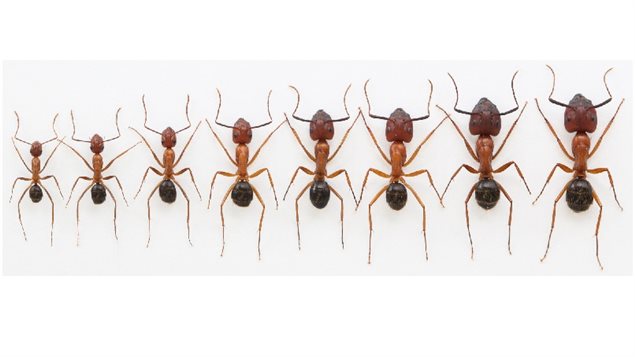Canadian researchers have made a startling discovery with potentially huge repercussions.
The research was carried out at McGill University in Montreal where the team discovered a mechanism controlling gene expression of growth such that they could environmentally (through epigenetics) adjust the control to result in the genetic creation of larger or smaller ants
Ehab Abouheif (PhD) is a professor in the Department of Biology at McGill, a Canada Steacie Memorial Fellow, and President of the Pan American Society for Evolutionary Developmental Biology
Listen
It has typically been thought that the traits of birds, animals (including humans) and fish, are genetically predetermined, and that environment can play a role, albeit a reduced and secondary role in such traits as size.
The researchers were studying Florida carpenter ants (Camponotus floridanus) and discovered that by simply increasing or reducing a common chemical- an environmental element- they could create ants of larger or smaller size within the same species.
The study, published in Nature Communications is entitled- Epigenetic variation in the Egfr gene generates quantitative variation in a complex trait in ants
The research team was led by Professors Moshe Szyf the McGill Departments of Pharmacology and Therapeutics and biologist Ehab Abouheif, and included PhD students Rajendhran Rajakumar and Sebastian Alvarado.
Epigenetics is the process where the degree of expression of a gene (its influence) can be modified through “methylation”, the chemical modification of genes, e.g greater or lesser methylation of a specific gene means that gene will have a greater or lesser effect on the development of the entity and vice versa.
What the team discovered is that environment can play a much bigger role in determining the development than was previously thought.
They found that by varying the degree of DNA methylation of a gene involved in controlling growth called Egfr, (epidermal growth factor receptor) they could vary the resultant size of ants.
Professor Abouheif points out that all creatures from ants to jellyfish to humans have this gene.
He also points out however that the degree to which the increase or decrease in size could occur remained within the typical range for the ant.
That is they couldn’t exceed the maximum methylation beyond the theoretical 100% limit such that if the maximum size of the ant species was genetically determined to be no smaller than (for example) 4mm and the biggest 10mm, by chemically (environmentally) manipulating the gene they could create ants of varying sizes within the range, but not for example create a 2mm or 20mm ant, or for that matter a 3 metre tall human.
This research for the first time shows how environment and genetics work together.
In other words, while there is no actual genetic DNA change, environmental factors such as nutrition plays an important role in the degree to which certain genes will be “turned up or turned down”.
In this case the Egfr gene is at the top of a chain so to speak. Co-lead author Sebastian Alvarado says, “Basically, what we found was a kind of cascading effect. By modifying the methylation of one particular gene, that affects others, in this case the Egfr gene, we could affect all the other genes involved in cellular growth. We were working with ants, but it was a bit like discovering that we could create shorter or taller human beings.”
Professor Abouheif points out that in the research it was somewhat easier to decrease the ant size than to increase them.
He also notes that McGill has a scientific ethics department where all issues regarding research like this can be discussed.
In the meantime he says, this will lead to further research by other scientists to see if, or to what degree this Canadian discovery will lead to benefits in a variety of areas from medicine to agriculture.







For reasons beyond our control, and for an undetermined period of time, our comment section is now closed. However, our social networks remain open to your contributions.